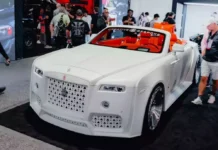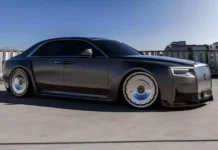A Dodge Charger Daytona R/T EV owner in Stillwater, Minnesota, was fined for something that didn’t even exist on his car: noisy exhaust pipes. The incident went viral, sparking debates about police enforcement, noise regulations, and Dodge’s controversial decision to equip its electric muscle car with a synthetic exhaust system.
Driver Mike shared a video of the incident on social media, quickly gaining attention. In the clip, a Minnesota state trooper tells him that his “super loud” exhaust is causing a disturbance.



The officer even noted that Mike had been previously warned about his exhaust, although Mike asserted that was when he drove a gas-powered car, not the electric Dodge Charger he was driving at the time.
While people mocked the officer in the comments, it’s clear they didn’t realize the car was actually equipped with a fake engine noise feature. Mike recalled the events leading up to the incident in a conversation with The Drive. He narrated how he was cruising with a group of enthusiasts through Stillwater, a town known for its strict noise ordinances.
When the light turned green at an intersection, the lead car in the group took off noisily, but Mike remained stopped at the red light behind. When confronted about the exhaust issue, Mike tried to explain the situation. “I tried to tell him it was electric and didn’t have an exhaust, and he said he wasn’t going to argue with me,” he said.
The truth is that you can’t adjust the volume of the fake V8 engine noise with any switch. Once it’s on, it’s indeed loud. However, you can control its intensity by selecting different driving modes. For example, it can wake up the entire neighborhood in settings like Drag, Drift, Donut, or Track, but it can be silent in Stealth mode.
The system dynamically responds to inputs such as throttle position, speed, and selected driving mode—making the sound louder or softer depending on how you drive. Drivers can opt for the Auto mode for quieter and more subdued sound. Perhaps that wasn’t what the officer heard coming from Mike’s Dodge Charger Daytona R/T.

The final citation listed three violations: operating with a loud exhaust, lack of vehicle registration, and causing a public disturbance. Mike asserted that the only sound his Charger could have made at that time was from Dodge’s controversial Fratzonic Chambered Exhaust system, a feature that has sparked backlash from car enthusiasts against the automaker.
Dodge went to great lengths to make its first electric muscle car sound like a traditional gas-powered vehicle. The Fratzonic Chambered Exhaust system actually uses chambers and speakers to create a synthetic V8 roar, reaching up to 126 decibels, equivalent to the roar of a supercharged Hellcat.
Dodge stated that this feature aims to maintain the exhilarating experience that muscle car enthusiasts expect, allowing the Charger EV to accelerate and roar like a V8-powered car without burning fossil fuels.

However, the execution proved divisive. Some enthusiasts appreciated all the theatrics it brought, arguing that it was a way to preserve Dodge’s muscle car identity in the electric age. Others found it unnecessary or even embarrassing.
In reality, the Fratzonic system is loud enough to invite complaints under existing noise laws, even though it’s technically not an exhaust. Minnesota law prohibits “excessive or unusual noise” from mufflers.

Mike asserted that he wasn’t even using the feature at the time of the stop. As his car was running low on battery, he had engaged the Auto mode, which minimizes the artificial noise. “I wasn’t making the noise, it was the car in front of me,” he explained. Nearly three months later, Mike is still unable to contest the fine as the case files aren’t showing up in the court system. He said he’s been calling weekly to schedule a court date, but to no avail.
Whether he gets fined or not, the incident highlights how existing laws are unprepared for the quirks of modern electric vehicles. It also reflects the confusion and conflict surrounding Dodge’s decision to include synthetic noise in its electric car.
For some, it may be the perfect bridge between tradition and technology. For others, it’s just a gimmick that’s now causing real-world troubles. As electric vehicle adoption increases, one thing is clear: this won’t be the last time someone gets fined for a “non-existent” exhaust.











































